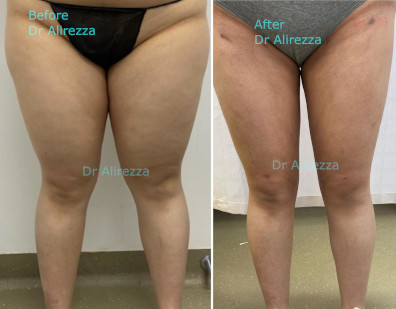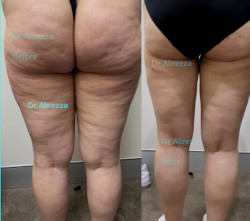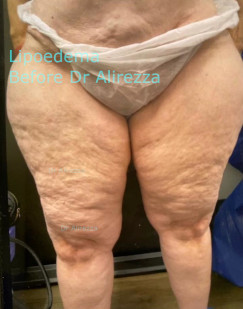To understand Lipedema it helps to understand how it relates to veins (Edema) and lymph channels (Lymphedema)
Veins, Lymph Channels and Fat
There are two systems in your body that prevent oedema.
Arteries constantly bring in fluid containing oxygen and nutrients.
Veins work hard to remove that fluid with a lot of waste protein, minerals,etc.
Fluid that is outside the veins can be removed by the lymph system.
If the veins and the lymph channels cannot keep up with what is coming in fluid and wastes will build up causing swelling, inflammation and damage.
Lipedema is a separate medical problem. Some people will have abnormal fat in some areas that becomes inflamed and causes damage. This a medical condition called lipedema. It is progressive and may eventually damage veins and lymph channels.
A key feature of Lipedema is Lipalgia (Painful Fat) which can be accompanied and made worse by weight gain and fluid accumulation (Lymphedema). It is easy to confuse lymphedema (fluid) with lipedema (fat). The two can also occur together – even more confusing.
Lipalgia
The key feature of Lipedema is tender fat when pressed (Lipalgia). At the beginning there may be no pain. With time inflammation worsens and tenderness starts. Eventually continuous pain may be present. Any episode of weight gain such as pregnancy will make the condition worse. Hormonal changes such as puberty, menarche, menopause and pregnancy can trigger lipedema to start or to get worse. Pain, frustration and loss of body image can cause stress which can increase weight gain and further deterioration. Weight gain is easy but weight loss for these patients is very difficult. All weight gain makes symptoms worse.
Why is Lipedema important?
Lipedema is progressive. You start puberty fit and strong with smooth skin. If you are unlucky fat will start to accumulate in areas where the metabolism in the fat is different. Adipose has been described as a powerful endocrine organ. It responds strongly to hormonal changes and in turn will have a strong influence on your hormones.
At the extremes obesity can make you infertile and being extremely under weight might stop your periods
Like all illnesses it is easier to treat if you start early. With time some of the changes of lipedema such as scarring may not be corrected. If the skin is stretched too much it might not fully shrink.
Lipedema is unhealthy
- Reduced Mobility – Lipedema causes disproportionate fat accumulation, particularly in the legs and arms, leading to heaviness, stiffness, and discomfort. As mobility decreases, physical activity becomes more difficult, resulting in weight gain and further progression of the condition.
- Accelerated Osteoarthritis Progression – The excess weight on the legs and joints increases mechanical stress, leading to faster cartilage breakdown. Additionally, the chronic inflammation associated with lipedema contributes to joint degeneration, further worsening osteoarthritis.
- Chronic Inflammation – Lipedema is an inflammatory disorder, and the constant low-grade inflammation can contribute to systemic issues, including increased susceptibility to infections, impaired healing, and exacerbation of other inflammatory conditions like autoimmune diseases.
- Energy Loss and General Malaise – Many individuals with lipedema experience extreme fatigue, often linked to chronic inflammation, poor lymphatic drainage, and increased metabolic stress. This can lead to difficulty in completing daily tasks and reduced quality of life.
- Lymphatic Dysfunction and Lymphedema Risk – Lipedema can impair lymphatic drainage, leading to fluid retention, swelling, and an increased risk of secondary lymphedema (lipolymphedema), which further worsens mobility and discomfort.
- Pain and Tenderness – Unlike regular obesity, lipedema fat is often painful to the touch. Patients frequently experience aching, bruising, and sensitivity, even with minor pressure, which can interfere with daily activities and sleep.
- Difficulty Losing Weight – Lipedema fat is resistant to diet and exercise. Traditional weight loss methods often do not significantly reduce affected areas, leading to frustration and misdiagnosis as simple obesity.
- Emotional and Psychological Impact – Many people with lipedema face body image issues, depression, and anxiety due to their appearance, chronic pain, and difficulty in managing their condition. Misdiagnosis or dismissal by medical professionals can add to emotional distress.
- Hormonal Influence and Worsening with Life Stages – Lipedema is strongly linked to hormonal changes, often worsening during puberty, pregnancy, and menopause. This hormonal connection makes management even more challenging, as the condition can progress despite lifestyle changes.
- Increased Risk of Cardiovascular Issues – While lipedema itself does not cause cardiovascular disease, associated weight gain, inflammation, and metabolic dysfunction may contribute to higher risks of conditions like hypertension and insulin resistance.
What does lipedema look like?
Lipalgia is a heterogeneous collection of patients, some have classic symptoms and others are more difficult to see.
The average patient starts with an ecto-endomorph body type (Pear shaped). The upper body has an average fat covering. From the waist down the fat covering is greater. A notable feature but not always present, is that the ankles and feet have an average fat cover. There may be a collar of fat above the ankles. Swelling can occur in the feet as it does in many people but it will go overnight. This does raise suspicion of venous insufficiency which may need to be assessed with doppler ultrasound.
30% can have upper arm involvement. Fat tenderness and pain might not be present at the start. 15% will have a family history of Lipalgia.
Diagnosis of Lipedema
Stage 0ne: lipedema begins as a stubborn area of fat that does not respond easily to diet.
Pain (Lipalgia): In the beginning your fat feels normal but as the condition progresses you will notice that the affected areas are more sensitive and may become painful. This is a distinguishing sign that helps to make the diagnosis.
Skin: Thickening of the skin may be difficult to detect in the early stages. The skin starts soft and smooth to touch, but as the skin gets thicker it becomes uneven, may develop an orange peel look that can be similar to cellulitis. Skin changes can become very marked.
Vascular fragility: In the vascular system of the affected area it may be possible to see broken capillaries, telangiectasia and varicose veins. This is a sign of vascular fragility. It may be necessary to have an echo-doppler of the affected areas in order to to completely understand the possible vascular damage. Varicose veins may need to be treated before having liposuction.
The affected areas may bruise easily. These bruises are slow to disappear and can leave pigmentation.
You feel: swelling and heaviness in the affected areas.
Distribution: When you have lipedema, the affected areas are out of proportion being larger than non-affected areas, but still symmetrical. The waist is often thinner than the rest of your body. In the lower limbs, joints such as the knees and ankles may disappear. In the upper limbs, the elbows and wrists are not very marked and are filled with fat.
A distinguishing feature of lipedema is that the feet and hands are unaffected and have a normal appearance.
With lipedema the condition is symmetrical with bilateral fat collections observed on the body.
Obesity and Lipedema
Lipalgia patients frequently develop two additional problems, Obesity and Lymphedema. If they can make the diagnosis early with careful management they can avoid obesity and lymphedema. Early control centers on weight control, anti-inflammatory diet, exercise and pain control. For the general population obesity and edema are more common with age. Patients with Lipalgia need extra vigilance to avoid these changes with age. Due to lack of diagnosis 80% of lipalgia patients are obese. Once you are diagnosed you will understand the great difficulty with losing any of the weight you gain. Not gaining weight is extremely important to avoid or slow progression.
Obesity and Lipo-Lymphedema
Fat has a very rich blood supply (More than muscles). Fluid in (Arteries) must balance fluid out (Veins and Lymph). New fat increases blood flow in rapidly. We grow lymph channels slowly which means that fluid out may be slow and fluid builds up (Edema). Long standing edema accumulates waste products that have not been cleared, significantly proteins. Lipo-edema develops. Waste accumulation triggers inflammation and inflammation slows new vessel growth. Reduced blood flow causes ischemic pain and more inflammation. Everything gets worse.
Stages:
First Stage
Lipedema only
Not obese and no Lymphedema.

Any weight gain will produce painful fat deposits. Stress and depression will make pain worse.
Weight control will stop any deterioration
- Excess fat from the waist to the upper ankle. Weight loss comes off the upper body but not the lower body. Weight distribution is symmetrical. Fat Pads around the knees.
- No fat or swelling in feet and ankles
- Skin healthy
- Tender fat. Patients without lipalgia do not have pain when pressed.
- Some patients will have pain at rest which does not respond to over the counter meds.
- Fat may contain nodules to palpation.
- Legs are prone to bruising

Second Stage:
Press your finger into the foot, if it leaves a depression this means that fluid is present (Simple edema). If there is no depression in the swelling then it is a fat pad. The skin over the foot should be mobile when picked up. That is normal. If the skin is not mobile when picked up then lymphedema (impaired lymph drainage) may be present. (Stemmers sign).
Lipalgia Plus Weight Gain.
- Fat nodules are easier to feel.
- Skin is deteriorating and fat deposits are more obvious.
- General weight gain.
- More pain.
Third Stage

Lipalgia, Weight Gain and Lipo-lymphedema.
These are chronic changes that have taken many years to develop and will take time to reverse.
Feet and ankles have swelling that does not resolve overnight (Early stages of lymph-edema). Skin over the feet can not be pinched up (Stemmers sign positive – late stages of lipo-lymphedema)
Thick, hardened skin with colour changes represents underlying fibrosis, inflammation, loss of skin elasticity and more fat deposits.
Fat deposits on the legs may develop unevenly and interfere with walking.
Incidence
Many people are not diagnosed yet but estimates of 11% of the population are likely at this stage. Some researchers feel that it could be as common as 1 in 5 women.
Diagnosis
15% of suffers will have a family history. Ask your mother, aunties etc.
Look in the mirror for a pear shape with thin feet and ankles, thin upper body, feel for lumps and tenderness.
If you have swelling of new lumps ask your doctor to rule out other problems and causes.
Lipalgia and Lipo-lymphedema have only recently been described so many doctors may not be fully conversant with them but he can rule out other causes that may be a problem.
Specialists who work in this area include weight management doctors, liposuction doctors, vascular surgeons and dermatologists.
Treatment
Diet
Inflammation is the common pathway of all illnesses. Anything you can do to reduce inflammation will help you. Start by reducing inflammatory food. Processing food increases the shelf life but removes the anti-inflammatory components. Wholegrain bread is medicine, processed white flour used to make white bread is poison for you. When you control your weight yo control your lipalgia.
Exercise
Moving works your muscle pumps and stimulates the flow of fluids out of your feet up into your legs and up into your abdomen, chest and heart. Any movement is good. Some people call it exercise, some call it dancing, Tai Chi, Yoga, etc. But the one thing they all have in common is movement and regular is better.
Compression garments.
Start with low pressure garments, (12-17mmHg). These reduce swelling, inflammation and pain.
Liposuction
This treatment is definitive in that it removes the abnormal fat that is causing the problem.
There is some discussion about which type of liposuction is best. Water-Assisted, Vaser, Laser, RF, Tumescent, etc. We have used and taught them all. There are minor differences but as the Horse Whisperer said “It is the hands that hold them not the particular piece of equipment that is most important.” The results are excellent in our hands.
Classification of Lipedema
Even though Lipedema can be different for everyone but it will still fall into one of these classifications. It is classified by stage (severity) and affected area (zones).
The 4 stages of lipedema
The evolution of lipedema can be divided into four stages.
If the condition is not managed, lipedema will progressively worsen:
- Stage I: Smooth skin surface, soft to the touch, uniform thickening of the skin.
- Stage II: Irregular skin surface, orange peel appearance, sensation of nodules on palpation. Often tender to touch.
- Stage III: Hard skin surface, increased skin volume, appearance of deformed limbs, functional discomfort, pain.
- Stage IV: lipo-lymphedema. Pressure on the lymph ducts from the excess fat and protein reduces performance causing lymphedema
The 5 areas of lipedema
These are determined according to the location (area) of the fatty deposits.
We can define five main areas of lipedema:
- Lipedema type I: Hips/buttocks.
- Lipedema type II: From buttocks to knees (included).
- Lipedema type III: Buttocks to ankles (included).
- Lipedema type IV: Arms.
- Lipedema type V: Calves only.
Phlebo-Lipo-Lymphedema (PLL)
There are three systems that are involved:
Phlebo: Venous insufficiency is when the veins are not able to return all the blood to the heart. As blood backs up swelling occurs in the feet and ankles. Varicose veins might be seen.
Lipo: (Lipedema) Is used to describe an abnormal condition in which fat accumulates, becomes inflamed and is tender to touch.
Lymphedema: Is when the lymph system is not able to clear all the fluid from around the cells back into the venous system. The lymph system will clear water faster than protein. This excess protein causes inflammation, thickening of the skin and there will be increased risk of infection (Cellulitis).
The excess fat in advanced Lipedema can put pressure around the lymph channels compressing them to cause lymphedema (Fluid accumulation). You then have two problems, fluid and fat. This is lipo-lipedema. If the veins are compromised (venous insufficiency) you then have Phlebo-Lipo-Lymphedema.
Treatment:
Comprehensive Decongestive Therapy (CDT) is the gold standard non-surgical treatment for managing PLL, consisting of:
- Manual Lymphatic Drainage (MLD): A gentle massage technique encouraging lymphatic fluid movement to alleviate swelling.
- Compression Therapy: Using custom-fitted compression garments or bandages to support the veins and lymphatic vessels, preventing fluid build-up.
- Exercise: Low-impact exercises, such as walking, swimming, or gentle leg movements, help improve circulation and lymph flow.
- Skin Care: Proper skin hygiene and moisturizing help prevent infections and skin breakdown.
Surgical treatment
- Endovenous laser treatment to correct venous insufficiency. Best done before liposuction.
- Liposuction to reduce the fat load. This treatment is definitive in that it removes the abnormal fat that is causing the problem.